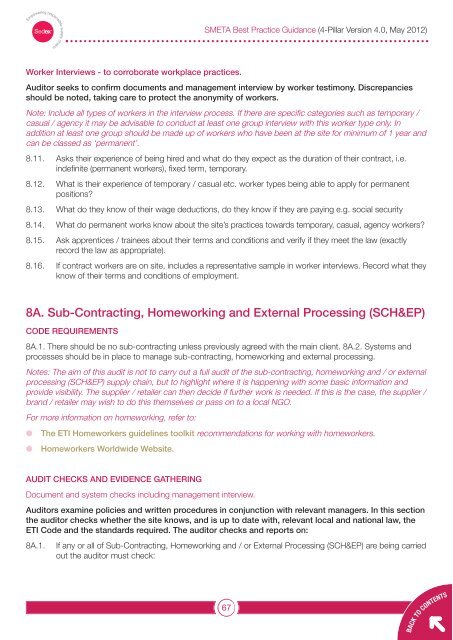Sedex Members Ethical Trade Audit (SMETA) Best Practice Guidance
Sedex Members Ethical Trade Audit (SMETA) Best Practice Guidance
Sedex Members Ethical Trade Audit (SMETA) Best Practice Guidance
Create successful ePaper yourself
Turn your PDF publications into a flip-book with our unique Google optimized e-Paper software.
Worker Interviews - to corroborate workplace practices.<br />
<strong>Audit</strong>or seeks to confirm documents and management interview by worker testimony. Discrepancies<br />
should be noted, taking care to protect the anonymity of workers.<br />
Note: Include all types of workers in the interview process. If there are specific categories such as temporary /<br />
casual / agency it may be advisable to conduct at least one group interview with this worker type only. In<br />
addition at least one group should be made up of workers who have been at the site for minimum of 1 year and<br />
can be classed as ‘permanent’.<br />
8.11. Asks their experience of being hired and what do they expect as the duration of their contract, i.e.<br />
indefinite (permanent workers), fixed term, temporary.<br />
8.12. What is their experience of temporary / casual etc. worker types being able to apply for permanent<br />
positions?<br />
8.13. What do they know of their wage deductions, do they know if they are paying e.g. social security<br />
8.14. What do permanent works know about the site’s practices towards temporary, casual, agency workers?<br />
8.15. Ask apprentices / trainees about their terms and conditions and verify if they meet the law (exactly<br />
record the law as appropriate).<br />
8.16. If contract workers are on site, includes a representative sample in worker interviews. Record what they<br />
know of their terms and conditions of employment.<br />
8A. Sub-Contracting, Homeworking and External Processing (SCH&EP)<br />
CODE REQUIREMENTS<br />
8A.1. There should be no sub-contracting unless previously agreed with the main client. 8A.2. Systems and<br />
processes should be in place to manage sub-contracting, homeworking and external processing.<br />
Notes: The aim of this audit is not to carry out a full audit of the sub-contracting, homeworking and / or external<br />
processing (SCH&EP) supply chain, but to highlight where it is happening with some basic information and<br />
provide visibility. The supplier / retailer can then decide if further work is needed. If this is the case, the supplier /<br />
brand / retailer may wish to do this themselves or pass on to a local NGO.<br />
For more information on homeworking, refer to:<br />
l The ETI Homeworkers guidelines toolkit recommendations for working with homeworkers.<br />
l Homeworkers Worldwide Website.<br />
AUDIT CHECKS AND EVIDENCE GATHERING<br />
Document and system checks including management interview.<br />
<strong>SMETA</strong> <strong>Best</strong> <strong>Practice</strong> <strong>Guidance</strong> (4-Pillar Version 4.0, May 2012)<br />
<strong>Audit</strong>ors examine policies and written procedures in conjunction with relevant managers. In this section<br />
the auditor checks whether the site knows, and is up to date with, relevant local and national law, the<br />
ETI Code and the standards required. The auditor checks and reports on:<br />
8A.1. If any or all of Sub-Contracting, Homeworking and / or External Processing (SCH&EP) are being carried<br />
out the auditor must check:<br />
67<br />
BACK TO CONTENTS


